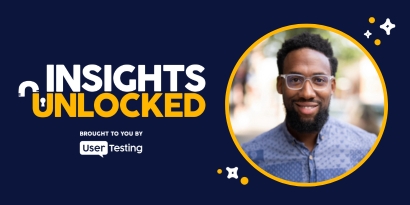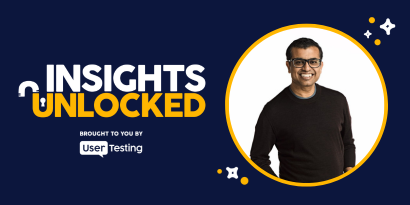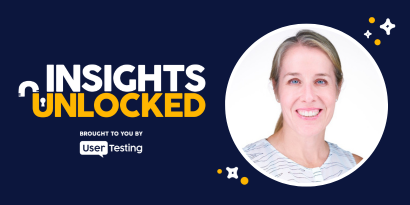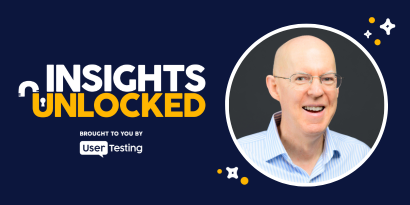
Episode 46 | June 28, 2022
Inclusive UX research and diversity with Temitayo Olasimbo
Learn how Temitayo Olasimbo brings inclusive UX research to life at Best Buy and why diversity is key to better design, strategy, and business outcomes.
How inclusive UX research transforms strategy and design
What happens when the people you’re designing for aren’t the people you’re researching with?
In the latest episode of Insights Unlocked, Temitayo Olasimbo, Research Operations Manager at Best Buy, reminds us why inclusive UX research is not just a checkbox—it’s the blueprint for building better products and more equitable experiences.
Inclusive UX research starts with intention
Temitayo is a passionate advocate for weaving diversity in user research into every step of the UX process. Her work at Best Buy reflects a broader movement: designing research practices that reflect the real world—its differences, its nuances, its humanity.
“We just always created these experiences using that one broad stroke,” she said. “Now, we’re doing things differently.”
That difference starts with intentional inclusive design. From participant recruitment to research synthesis, Temitayo’s team sets clear standards—like requiring 50% BIPOC representation and 20% accessibility-focused participants in every study. These aren’t aspirational goals; they’re mandates that ensure every voice has the potential to shape product strategy.
Report
2024 Retail Benchmark Report
Why diversity in user research matters
Too often, UX research operations default to convenience sampling, overlooking historically underrepresented communities. But doing so doesn’t just result in incomplete data—it leads to incomplete products. Temitayo likens the work to storytelling.
“When you’re able to really tell a good story,” she said, “you’re going to be able to invoke people to care about a particular subject.”
And when you care, you design better. That’s the power of human-centered design driven by empathy, not assumption.
Building infrastructure for equity
Inclusive UX research isn’t just about who you talk to—it’s about how you build the systems that support that research. Temitayo’s team manages vendor accountability in research from the start, ensuring external partners are aligned with Best Buy’s DE&I goals.
“I don’t like gotchas,” she explained. “That’s not being equitable. I needed to establish goals—and they had to be attainable and fair.”
These goals extend beyond race and gender to include considerations for disability, age, and even generational communication styles. “The way that you talk to an older population is very different from how you talk to Gen Z,” she noted. That insight is key for conducting accessible user research and building inclusive experiences.
Real insights lead to real strategy
So what’s the business case? For Temitayo, it’s straightforward: without inclusive research, your strategy is only half-informed.
“If you are not taking advantage of the insights that you gain from research, and you’re not designing those products to fit those insights, then your strategy is all for naught,” she said.
Today’s consumers expect products to reflect their values and lived experiences. Companies that fail to keep pace are at risk of being reactive, not proactive. It’s not just a moral imperative—it’s good business.
The future belongs to inclusive researchers
According to a recent UserTesting survey, only about half of UX professionals say DEI in technology is part of their standard practice. For Temitayo, that’s a sign the industry has more work to do.
“If industries and businesses do not start taking this seriously,” she warned, “they are going to be caught… when all of these consumers that are asking for more… that also includes a population that is getting more diverse as we speak.”
By embracing research participant diversity, UX leaders don’t just build better products—they build trust, relevance, and resilience in a rapidly changing world.
“When you're creating a strategy, you have to think holistically about the people that are consuming whatever experience or products that you are offering,” Temitayo said.
Episode links:
- How to ensure UX research supports DE&I priorities: This on-demand webinar features Amy Stone, Ph.D., and Jennifer Keus discussing the importance of recruiting diverse participant samples, the impacts of a diversified recruitment pool, and best practices for recruiting diverse audiences.
- The UX research methodology guidebook: This comprehensive guide offers insights into various UX research methodologies, helping researchers choose appropriate methods and interpret results effectively. It emphasizes the importance of planning and understanding different research types to gather inclusive and representative user insights.
- Unleashing the power of research across your organization: In this Insights Unlocked episode, Behzod Sirjani discusses democratizing research, measuring its impact, and tackling diversity and inclusion in research practices. The conversation provides strategies for integrating inclusive research practices across organizations.
- Diversity and inclusivity in UX research: how and why it matters: This blog post delves into the significance of including diverse perspectives in UX research. It outlines the definitions of diversity and inclusion, the importance of representing various user groups, and practical steps to ensure inclusive research practices.









